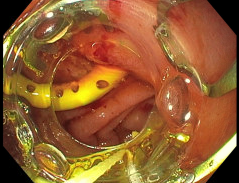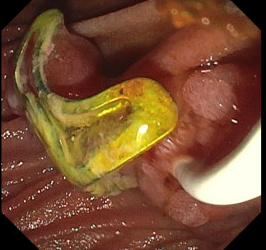Tuesday Poster Session
Category: Interventional Endoscopy
P5716 - Endoscopic Closure of Iatrogenic Duodenal Perforation With Over-the-Scope Clip (OTSC): A Minimally Invasive Solution After Drain Malposition
Tuesday, October 28, 2025
10:30 AM - 4:00 PM PDT
Location: Exhibit Hall

Vishnu Yanamaladoddi, MD
Creighton University School of Medicine
Phoenix, AZ
Presenting Author(s)
Vishnu Yanamaladoddi, MD1, Vikash Kumar, MD1, Aalam Sohal, MD1, Ashujot K. Dang, MD2, Anitha Choppavarapu, MBBS3, Indu Srinivasan, MD1
1Creighton University School of Medicine, Phoenix, AZ; 2University of California Riverside School of Medicine, Riverside, CA; 3Apollo Hospital, Nellore, Andhra Pradesh, India
Introduction: Perforations and post-operative fistulas are complications seen after abdominal surgeries, often requiring surgical intervention. Over-the-scope clip (OTSC, Ovesco) is a novel endoscopic device for full-thickness closure of GI perforations, fistulas, and non-variceal bleeding. It offers full-thickness tissue capture and strong closure. We present a case of a 31-year-old male who developed a duodenal perforation from a malpositioned drain, successfully treated with OTSC
Case Description/
Methods: A 31-year-old healthy male sustained polytrauma after a high-speed motor vehicle accident. Injuries included grade 4 liver laceration, rib fractures, left carotid pseudoaneurysm, and 11% TBSA burns. He underwent hepatic embolization and IR-guided drainage. On transfer, chest tube drainage revealed bile-stained fluid, suggesting bile leak. Laparotomy revealed bile peritonitis, 5L hemoperitoneum, necrosis of hepatic segments 7/8, diaphragmatic injuries, and biloma. Necrotic liver debridement, biloma washout, diaphragmatic repair, cholecystectomy, and trans-cystic drainage were performed.
Bilirubin remained elevated (7.3 mg/dL). Planned ERCP was delayed due to hematemesis. EGD showed a bleeding gastric ulcer treated with epinephrine and gold probe. CT revealed a 15.4 cm biloma; new drain was placed. ERCP showed a migrated pigtail drain in the duodenum with contrast leak from cystic duct and hepatic parenchyma. A 10F biliary stent was placed with rapid improvement. Later, tube feeds appeared in JP drain. CT suggested enteric fistula from drain migration. Endoscopy revealed drain in duodenum; it was removed and the defect closed with OTSC. He recovered uneventfully. At follow-up, the stent was removed and OTSC remained intact without recurrence.
Discussion: This case illustrates the utility of the OVESCO over-the-scope clip (OTSC) system as a safe and effective endoscopic intervention for closure of iatrogenic duodenal perforations. In our patient, the OVESCO clip allowed for a minimally invasive, rapid, and secure closure without surgical intervention. This reinforces the role of advanced endoscopic techniques in managing complex gastrointestinal complications and supports the growing evidence favoring OVESCO for select non-malignant, full-thickness duodenal defects. Only a handful of case reports and series exist. While it has shown high success and low complication rates, further studies are needed to evaluate the technique more deeply.

Figure: 1 - Placement of over-the-scope (OVESCO) clip

Figure: 2 - Intact OVESCO visualized during removal of biliary drain
Disclosures:
Vishnu Yanamaladoddi indicated no relevant financial relationships.
Vikash Kumar indicated no relevant financial relationships.
Aalam Sohal indicated no relevant financial relationships.
Ashujot Dang indicated no relevant financial relationships.
Anitha Choppavarapu indicated no relevant financial relationships.
Indu Srinivasan indicated no relevant financial relationships.
Vishnu Yanamaladoddi, MD1, Vikash Kumar, MD1, Aalam Sohal, MD1, Ashujot K. Dang, MD2, Anitha Choppavarapu, MBBS3, Indu Srinivasan, MD1. P5716 - Endoscopic Closure of Iatrogenic Duodenal Perforation With Over-the-Scope Clip (OTSC): A Minimally Invasive Solution After Drain Malposition, ACG 2025 Annual Scientific Meeting Abstracts. Phoenix, AZ: American College of Gastroenterology.
1Creighton University School of Medicine, Phoenix, AZ; 2University of California Riverside School of Medicine, Riverside, CA; 3Apollo Hospital, Nellore, Andhra Pradesh, India
Introduction: Perforations and post-operative fistulas are complications seen after abdominal surgeries, often requiring surgical intervention. Over-the-scope clip (OTSC, Ovesco) is a novel endoscopic device for full-thickness closure of GI perforations, fistulas, and non-variceal bleeding. It offers full-thickness tissue capture and strong closure. We present a case of a 31-year-old male who developed a duodenal perforation from a malpositioned drain, successfully treated with OTSC
Case Description/
Methods: A 31-year-old healthy male sustained polytrauma after a high-speed motor vehicle accident. Injuries included grade 4 liver laceration, rib fractures, left carotid pseudoaneurysm, and 11% TBSA burns. He underwent hepatic embolization and IR-guided drainage. On transfer, chest tube drainage revealed bile-stained fluid, suggesting bile leak. Laparotomy revealed bile peritonitis, 5L hemoperitoneum, necrosis of hepatic segments 7/8, diaphragmatic injuries, and biloma. Necrotic liver debridement, biloma washout, diaphragmatic repair, cholecystectomy, and trans-cystic drainage were performed.
Bilirubin remained elevated (7.3 mg/dL). Planned ERCP was delayed due to hematemesis. EGD showed a bleeding gastric ulcer treated with epinephrine and gold probe. CT revealed a 15.4 cm biloma; new drain was placed. ERCP showed a migrated pigtail drain in the duodenum with contrast leak from cystic duct and hepatic parenchyma. A 10F biliary stent was placed with rapid improvement. Later, tube feeds appeared in JP drain. CT suggested enteric fistula from drain migration. Endoscopy revealed drain in duodenum; it was removed and the defect closed with OTSC. He recovered uneventfully. At follow-up, the stent was removed and OTSC remained intact without recurrence.
Discussion: This case illustrates the utility of the OVESCO over-the-scope clip (OTSC) system as a safe and effective endoscopic intervention for closure of iatrogenic duodenal perforations. In our patient, the OVESCO clip allowed for a minimally invasive, rapid, and secure closure without surgical intervention. This reinforces the role of advanced endoscopic techniques in managing complex gastrointestinal complications and supports the growing evidence favoring OVESCO for select non-malignant, full-thickness duodenal defects. Only a handful of case reports and series exist. While it has shown high success and low complication rates, further studies are needed to evaluate the technique more deeply.

Figure: 1 - Placement of over-the-scope (OVESCO) clip

Figure: 2 - Intact OVESCO visualized during removal of biliary drain
Disclosures:
Vishnu Yanamaladoddi indicated no relevant financial relationships.
Vikash Kumar indicated no relevant financial relationships.
Aalam Sohal indicated no relevant financial relationships.
Ashujot Dang indicated no relevant financial relationships.
Anitha Choppavarapu indicated no relevant financial relationships.
Indu Srinivasan indicated no relevant financial relationships.
Vishnu Yanamaladoddi, MD1, Vikash Kumar, MD1, Aalam Sohal, MD1, Ashujot K. Dang, MD2, Anitha Choppavarapu, MBBS3, Indu Srinivasan, MD1. P5716 - Endoscopic Closure of Iatrogenic Duodenal Perforation With Over-the-Scope Clip (OTSC): A Minimally Invasive Solution After Drain Malposition, ACG 2025 Annual Scientific Meeting Abstracts. Phoenix, AZ: American College of Gastroenterology.
